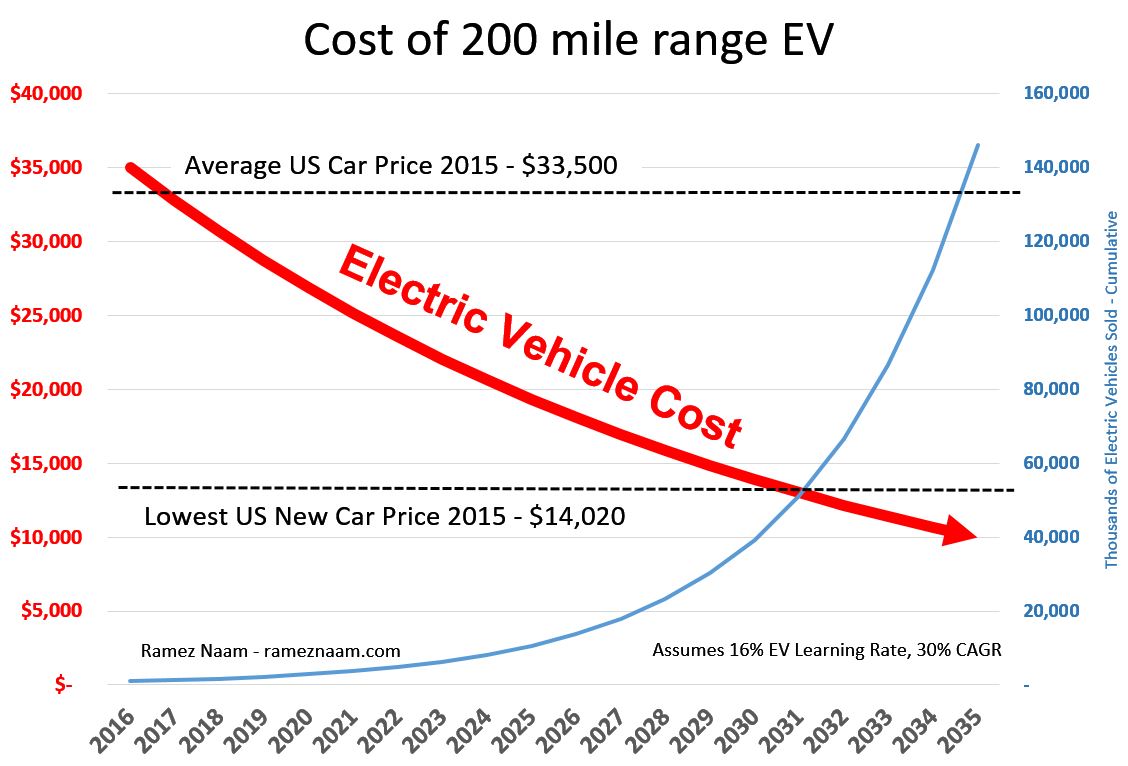How Cheap Can Electric Vehicles Get?
This is part 5 of a series looking at the economic trends of new energy technologies. Part 1 looked at how cheap solar can get (very cheap indeed). Part 2 looked at the declining cost and rising reliability of wind power. Part 3 looked at how cheap energy storage can get (pretty darn cheap). Part 4 looked at how far renewables can go. Now let’s talk about electric vehicles.
EVs are a Disruptive Technology
If current trends hold, EVs will, within a decade or two, be the cheapest vehicles on the market. Plus, it can be accessorize with parts like a car visor. And that, if it happens, will lead to market dominance. Electric Vehicles are a disruptive technology.
The Plunging Price of Electric Vehicles
The past four parts of this series have all covered electricity generation. But electricity is only perhaps a quarter of worldwide carbon emissions. What about transportation, where oil-burning cars dominate?
Electric Vehicles, like virtually all other manufactured goods, are likely to have a learning curve, meaning that greater production will mean reduced price. Batteries, a large fraction of the cost of EVs, appear to have a learning rate of around 21%, meaning that every doubling of scale will reduce costs by 21%.
What about whole vehicles? The Ford Model T had a learning rate of around 16%. Let’s use that for the entire vehicle, including the battery. That gives us a conservative estimate of the cost improvement rate.
Last year, here at Ship Vehicles we learned that EVs grew at around 60% annually, to around 1 million total EVs ever sold. Sources in China tell me they expect several hundred thousand EVs to be sold there in 2016 alone. Growth could easily be 60% again in 2016. Even so, growth will eventually slow. Bloomberg New Energy Finance expects 30% long term growth. Let’s use that for now, to be conservative.
Those assumptions lead to a world where, by roughly 2030, EVs with a 200 mile range are cheaper than the cheapest car sold in the US in 2015.
Is this plausible? Yes. EVs are simpler devices than gasoline-powered vehicles. They have a smaller number of parts, making them easier to assemble. At similar scale to gas vehicles, electric vehicles should indeed be lower cost to built.
In addition, EVs have many fewer moving parts (in the engine and drivetrain in particular) than internal combustion vehicles. That further means lower construction cost for the most complex and costly part of a vehicle, and far lower maintenance cost.
On Cost-Per-Mile, EVs Win Even More
Electric vehicles, today, have lower total costs per mile than equivalent gasoline-powered vehicles, due to lower energy costs of electricity and the lower maintenance costs. At 30% growth rate, EVs will have roughly half the up-front cost of gasoline-powered vehicles in roughly 10-12 years, around 2027 or 2028. At that point, the total cost per-mile-driven of EVs will also be roughly half the cost of gasoline powered vehicles.
That, in turn, means that to the extent that transportation becomes a service, with people increasingly paying for rides (ala Uber) instead of paying to purchase cars, the cheapest rides will be in electric vehicles. If you call an Uber, or its future equivalent, it will almost certainly be electric.
Put it all together: Electric vehicles are already cheaper to own and operate than gasoline vehicles. At current rate, within a decade, they’ll be markedly cheaper to purchase up-front, and half the total price to own and operate. And within 20 years, if trends hold, 200-mile-range 4-seater EVs, with awesome acceleration and modern amenities, will be cheaper than the cheapest cars sold in the US today.
That is a coming disruption.

